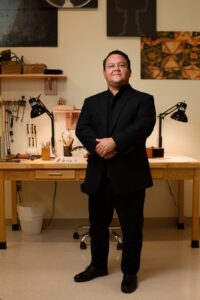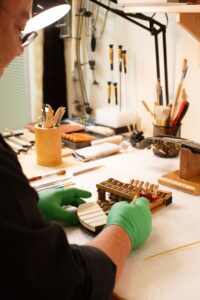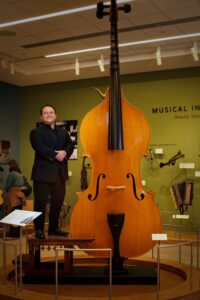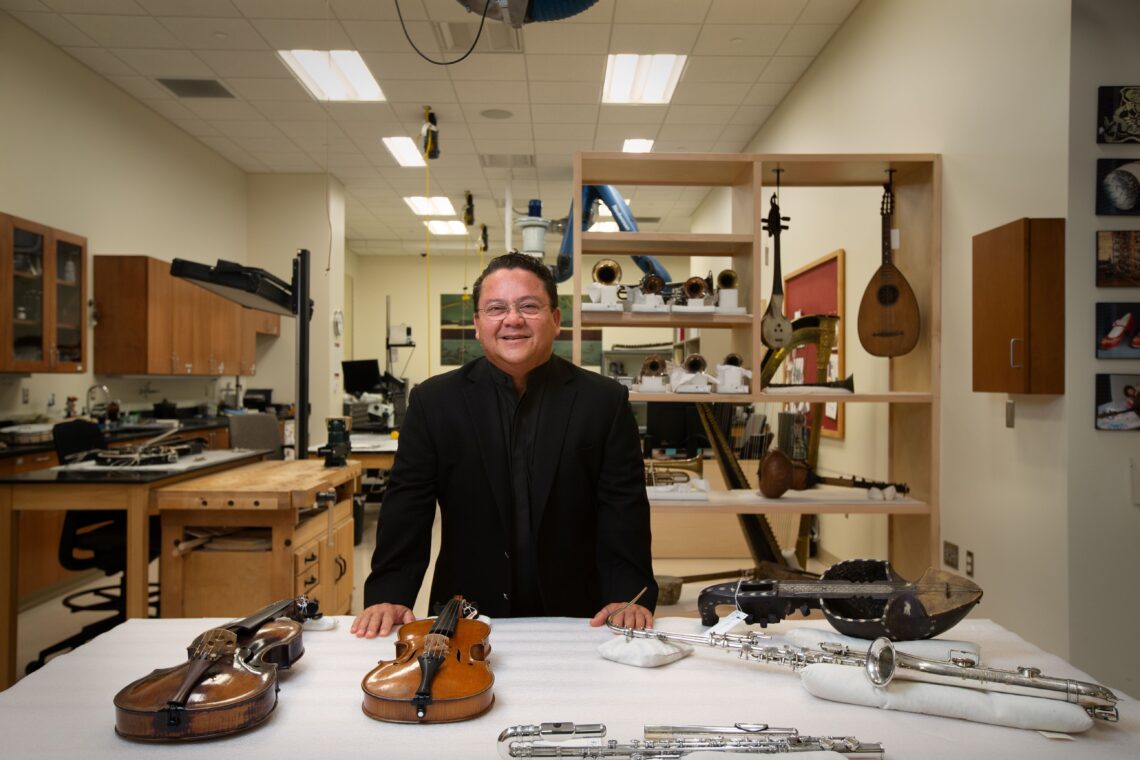Writer Rebecca L. Rhoades // Photography by Loralei Lazurek



British composer Sir Stephen Hough once said, “Few occupations pass the solitary hours more fruitfully than the playing of a musical instrument.” The same could be said about restoring them. Just ask Rodrigo Correa-Salas, who spends his days surrounded by instruments.
“Every day is something different, and every day is a learning process,” he says. “It’s magic.”
Correa-Salas is the conservator at the Musical Instrument Museum in Phoenix. He is responsible for cleaning, repairing, restoring and getting ready for display every instrument and associated artifact that is brought into the museum.
And thanks to an ever-expanding permanent collection of more than 13,000 instruments and objects — spanning thousands of years and about 190 countries — and a regular rotation of temporary exhibits, offers new challenges, new surprises — and plenty of joyful satisfaction.



Behind the Scenes
It’s a random afternoon in March, and Correa-Salas is busy in the museum’s conservation lab. The bright, airy workshop is located on the ground floor of the MIM, directly across from the Experience Gallery. A large picture window offers inquisitive patron a peek into the restoration process.
Tabletops are lined with an assortment of rare and unusual instruments. An 1800s violin and a 17th-century viola share space with a 1920s Indian sarinda (lute) and a shiny metal saxophone-shaped Italian rothophone from 1900. A mid-19th-century drum from the Congolese Batetela people rests on its side as a recent mend to its animal skin drumhead cures. Nearby, a 1680s German viola de gamba, 18th-century sarinda and 19th-century Chinese mouth organ wait in various states of repair.
And at the front of the room, Correa-Salas sits at his workbench. Before him is an 1810 tastengitarre, or keyed guitar. Similar in size and shape to an early 19th-century German guitar, it also features a piano hammer mechanism. On this day, Correa-Salas has removed the keys and, with the delicate precision of a surgeon, is cleaning them with tweezers, steel picks and tiny brushes.
“Rodrigo is expected to work with a staggering diversity of objects, and therefore and equally staggering range of conservation challenges,” says Rich Walter, MIM curator for USA/Canada. “He had a specialized set of skills even before coming to the MIM, and through exposure to countless objects from around the world, he became familiar with woods, animal skins, metals, adhesives, pigments, textiles and natural fibers, and all the different ways of securing those materials together to make functional instruments.”



True Calling
It’s almost as though Correa-Salas was predestined for the position of curator.
“I always loved to see how things work and to fix them,” he says. “I’ve been disassembling and assembling things all my life.”
Correa-Salas was born in Santiago, Chile, into a family of musicians and artists. His grandfather was an orchestra conductor, and his mother danced professionally. And his two brothers were a visual artist and a musician, respectively.
When Correa-Salas was 6, his mother moved him and his brothers to Venezuela, and when he was 17, the family relocated to Puerto Rico. It was here that he first began playing the cello, and within a year, he was accepted into the Puerto Rico Conservatory of Music, where he studied initially studied cello performance but later switched to music education.
After graduating, Correa-Salas moved to Bloomington, Indiana, to attend Indiana University.
“My brother was getting his master’s degree in piano performance there, and he told me about a degree in violin making,” he recalls. “It was great because it combined music, sound, making things and restoring things. And because the university is such an important music school, I had the opportunity to have a lot of important instruments around me.”
In 2000, he returned to Puerto Rico and opened a Montessori preschool with his mother. They converted their house into the school, and Correa-Salas taught music classes and ran a violin repair shop.
Eight years later, he closed the school. It was about this time that he was appointed the custodian of the cello of the legendary Puerto Rican cellist Pablo Casals. He also became the official luthier of the Casals Festival, an annual classical music festival founded in honor of the renowned musician.
“I was traveling to a lot of different places — Europe, Central America, the United States, and working with different orchestras, musicians and even a few museums,” Correa-Salas says. “It was a learning process with different types of instruments and companies.”
Similar stints in Chile and Panama followed. And then, in 2017, Correa-Salas received a call from Manuel Jordán, deputy director and chief curator at the MIM.
“He knew of my work at the Pablo Casals Museum,” Correa-Salas says. “He invited me to come to Phoenix, of course knowing that I was going to love the place. When I saw the museum, it was ‘wow!’ I could not say no.”



Part of the Magic
For the past six years, Correa-Salas has played an integral role in each step of an instrument’s journey through the museum. From checking the instrument into the museum’s system to cleaning and repairing it, from photographing the restored piece for archival purposes and even assisting the curators in the proper display of each piece, he is there throughout the entire process.
“Having a talented and reliable conservator is invaluable to any museum,” Walter says. “The curatorial and exhibits teams constantly consult with Rodrigo as we are evaluating objects for display, observing their condition over time, and in many cases, in advance of making final decisions about acquisitions.
“When we have historic instruments that need minor repairs, or perhaps a specialized part to help make them complete, Rodrigo can make the difference between our ability to feature certain objects in an exhibit or not.”
Instruments can take months, even years, to repair. Correa-Salas points to the 18th-century sarinda, which he slowly has been bringing back to life.
“I have to make the tuning pegs and the bridge,” he explains. “I’ve made little sketches, and I’ve already prepared the wood. I’m trying to copy the same kind of materials that originally would have been used.”
Another instrument that required Correa-Salas’ specialized skills is a rare circa-1870 Indian swarabat. The stringed lute instrument is one of only five in existence, so finding information was especially challenging.
“I had to make a lot of things for this instrument, [including the bridge, tuning pegs and camel-bone details],” Correa-Salas says.
He also repaired the peacock-shaped pegbox, added strings and touched up the painted flowers on the body.
“So many times, I have to make parts because we can’t just buy them if the instrument is really old,” he adds. “But that’s what’s fascinating about my job.”
Correa-Salas estimates that since arriving in Phoenix, he’s worked on about 50% of the museum’s collection. And every day, he tours the exhibitions to gaze over the 5,000 or so that are on display. He checks if they need polishing, repairs or additional upkeep. Humidity, dust and overzealous touchy-feely museum visitors keep him on his toes.
As he stands in the Middle East Gallery, he reaches out to adjust the display angle of the swarabat. It’s one of his favorite pieces. He reflects on the precious instrument’s 150-year-old narrative — one that now includes him.
“Each instrument has some kind of magic,” he says with a smile. “And when I do something to an instrument, I become part of its history. It’s a really intense experience.”







Comments by Admin